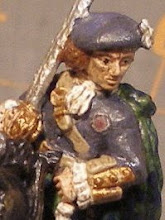As promised in my last post, here are the initial units and commanders for my burgeoning German and French forces for the 1870-1871 Franco-German (AKA Prussian) War. In raising my forces, I've been concentrating on the Republican phase of the war from after the fall of Sedan and the abdication of Napoleon III (the Little) in late 1870 through the final French surrender in early 1871. My German forces are organized around the Prussian IX Korps with its 18th Prussian and 25th Grand Ducal Hessian Divisions, reinforced by the 6th Prussian Cavalry Division. My French forces are an amalgam called the 15th Corps, 1st Army of the Loire with the 1st and 2nd Infantry Divisions and the 15th Cavalry Divisions.
First the Hessians:
 |
| Command Group, 49th Brigade, 25th Grand Ducal Hessian Division |
The commander of the 49th Brigade, 25th Grand Ducal Hessian Division was Oberst (Colonel) von Winckler. Here he is represented by a figure titled "Baron von Gruber, EXT-15." But I can't recall from which manufacturer I procured him. (Anyone have any idea?) He's a nice stout German officer adjusting his monocle for a better view of the battlefield. His aide, a vintage Scruby 1" Prussian officer, is holding his bay mare (made by Castaway Arts in Australia). His brigade will consist of the 1st "Life Guard" Infantry Regiment, the 2nd "Grand Duke's" Infantry Regiment, and the 1st Guards Jager Battalion.
 |
| Hessian 1st Guards Jager Battalion |
This battalion is composed of 24 Helion figures of Prussian jagers from their 1866 line, now sold by Northstar Miniatures. These are very well sculpted figures and with the proper paint job pass easily for Hessian jagers.
And now some French:
 |
| Command Group, 1st Infantry Brigade, 2nd Infantry Division |
In my version of the French 15th Corps, 1st Army of the Loire, the 1st Infantry Brigade, 2nd Infantry Division is commanded by General de Brigade Daries. The general and his horse are Falcon Miniatures castings while the aide is from Castaway Arts. His brigade will consist of the 30th Regiment de Ligne de Marche and the Volontaires de l'Ouest (the former Papal Zouave Regiment). In the French Republican forces, "march" units were created using the various depot battalions, late mobilizers, and new recruits. Some of them were good, solid units and some weren't. I haven't decided how good (or poor) the 30th will be. The Volontaires were a very good unit who fought with great courage, many of the men being long-term professionals from their service in Italy in defense of the Pontifical States and Rome itself.
As an aside, the colored dots on the rear of the base designate which regiments are in this brigade -- white and red for the 30th and medium blue for the Volontaires. All of my units have their own distinct "dot" and their brigade and division commander groups have dots from all their subordinate units. This allows a player to keep track of who belongs to whom in the heat of the battle.
Next is part of the 5th Chasseur (light infantry) Battalion of the 1st Brigade, 1st Loire Division.
 |
| 5th Chasseur Battalion with a mix of Foundry and Castaway Arts infantry and some unidentified manufacturer's officers. |
I still have another six figures to paint to complete the battalion but only have four on-hand. But that's OK as we only need 4 stands per unit for our game in January being run by our visiting Tim C. from North Carolina (an original member of the Jackson Gamers from our days at Mississippi State University in the early 1970s). He brings his computer and the Carnage and Glory rules every Martin Luther King holiday for a game. This year being the 150th anniversary of the war, we decided to start off with a bang.
 |
| Unidentified manufactuer's French officers. |
Can you help identify the manufacturer of these two French officers? They are not Foundry (as far as I can tell from their current listings) or Castaway Arts. Any assistance would be appreciated.
 |
| 3rd Battalion, 25th Gardes Mobiles de Gironde |
And the final unit is a battalion of Gardes Mobiles from the Department of the Gironde. I chose this unit because its troops were in the French Loire forces and there is a nice illustration of a soldier in the Osprey Republican France volume. This battalion also has one of those unidentified manufacturer's officers. I believe that I got these figures from the late Mark "Doc Ord" Stevens, one of our Jackson Gamers stalwarts. According to the Osprey, they were armed with the .43 Egyptian (11 mm) Remington rolling block rifle. We'll see how well (or poorly) they do in the January game.
Well, that's all for November's painting. Next up are the two battalions and regimental commander of the Hessian 2nd "Grand Duke's" Infantry Regiment, a Hessian light artillery battery, and a French heavy artillery battery, plus the regimental commander for the 25th Gardes Mobiles de Gironde.
I hope that all my American readers had a wonderful and filling Thanksgiving!






















































